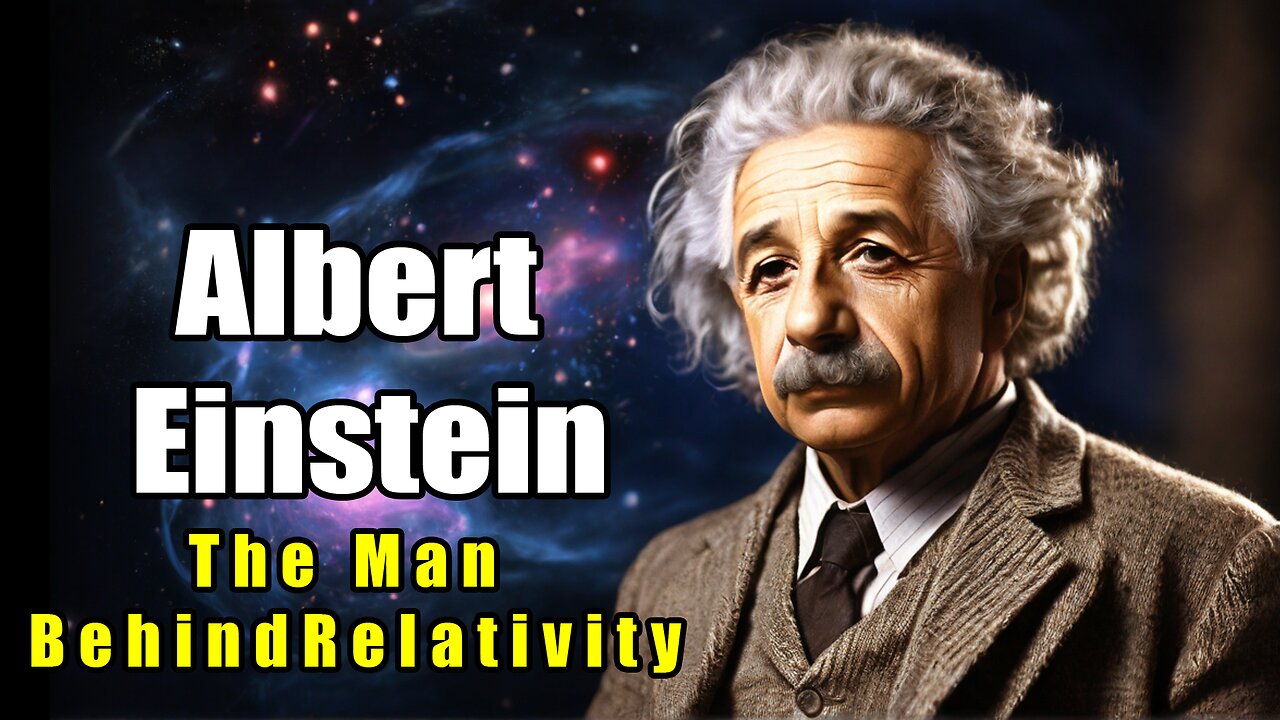Premium Only Content

Albert Einstein - The Man Behind Relativity Theory (1879 - 1955)
Albert Einstein (1879-1955) was a theoretical physicist renowned for his contributions to the development of modern physics, most notably the theory of relativity. Here is an exploration of Einstein's life and his groundbreaking work on the theory of relativity:
Early Life and Education:
Birth and Childhood:
Albert Einstein was born on March 14, 1879, in Ulm, in the Kingdom of Württemberg in the German Empire.
Education and Academic Struggles:
Einstein showed an early interest in mathematics and physics but faced challenges in the traditional school system. He later attended the Swiss Federal Institute of Technology (ETH Zurich).
Career and Scientific Contributions:
Annus Mirabilis Papers (1905):
In 1905, often referred to as Einstein's Annus Mirabilis (Year of Miracles), he published four groundbreaking papers that transformed physics. These papers covered the photoelectric effect, Brownian motion, special relativity, and mass-energy equivalence (E=mc²).
Special Theory of Relativity (1905):
Einstein's special theory of relativity introduced the revolutionary concept that time and space are intertwined and relative to the observer's motion.
General Theory of Relativity (1915):
Einstein extended his theory with the development of the general theory of relativity, proposing that gravity is not a force but a curvature of spacetime caused by mass and energy.
Einstein's Equation (Field Equations):
The general theory of relativity is encapsulated in Einstein's field equations, a set of ten interrelated differential equations.
Public Recognition and Nobel Prize:
Nobel Prize in Physics (1921):
Einstein was awarded the Nobel Prize in Physics in 1921 for his explanation of the photoelectric effect, a key aspect of quantum theory.
Einstein's Public Persona:
Einstein's iconic image became widely recognized, and he used his platform to advocate for pacifism, civil rights, and education.
Later Life and Exile:
Emigration to the United States:
Due to the rise of the Nazi regime in Germany, Einstein, who was of Jewish heritage, emigrated to the United States in 1933.
Atomic Bomb Letter (1939):
Einstein played a role in alerting the U.S. government to the potential development of atomic weapons by Nazi Germany, leading to the establishment of the Manhattan Project.
Legacy and Later Work:
Post-War Years:
After World War II, Einstein continued his scientific pursuits, working on unified field theory, although he did not achieve the breakthrough he sought.
Death and Immortality of Ideas:
Albert Einstein died on April 18, 1955, in Princeton, New Jersey. His ideas, particularly those related to relativity, continue to shape modern physics and have had profound implications for our understanding of the universe.
Cultural Impact:
Pop Culture Icon:
Einstein's disheveled appearance, unique fashion sense, and iconic equations have made him a symbol of genius in popular culture.
E=mc²:
Einstein's equation, E=mc², has become one of the most recognizable symbols in physics, representing the equivalence of energy (E) and mass (m) multiplied by the speed of light (c) squared.
Albert Einstein's contributions to physics, particularly his theories of relativity, revolutionized our understanding of the fundamental nature of space, time, and gravity. Beyond his scientific achievements, Einstein's advocacy for human rights and his status as a cultural icon have left an indelible mark on history.
-
 14:13
14:13
Clickbait Wasteland
13 hours ago $2.22 earnedAsking New Yorkers Who they Support for Mayor: Harlem
17K22 -
 19:55
19:55
The Rad Factory
14 hours ago $0.48 earnedCan I Fix My Fire Damaged F1 Car?
3.71K1 -
 1:26:22
1:26:22
Dialogue works
2 days ago $0.20 earnedScott Ritter: Russia Just DEFIED the U.S.: We'll End the War on OUR Terms!
6656 -
 LIVE
LIVE
BEK TV
23 hours agoTrent Loos in the Morning - 8/01/2025
338 watching -
 13:08
13:08
Dad Saves America
12 hours ago $0.86 earnedTeachers Unions Play Politics While Students Lag Behind - Poisoning of the American Mind: Pt 4
11.4K9 -
 20:05
20:05
Preston Stewart
13 hours ago $1.59 earnedCrimea Raid to Chasiv Yar Fight
10.9K8 -
 8:11
8:11
Millionaire Mentor
15 hours agoTulsi Gabbard and Leavitt DOUBLE-TEAM Kaitlan Collins in FIERY Exchange
8.87K6 -
 46:02
46:02
Coin Stories with Natalie Brunell
1 day agoWhat They’re Hiding About the Economy | Natalie Brunell with Danielle DiMartino Booth
42K7 -
 12:12
12:12
GritsGG
14 hours ago23 Warzone Wins in a Row! (Cypher AR)
84.1K3 -
 2:12:07
2:12:07
Side Scrollers Podcast
21 hours agoCULTURE SHIFT CAUSES MELTDOWNS + MASSIVE CENSORSHIP EFFORTS RAMP UP | SIDE SCROLLERS LIVE
26.8K12